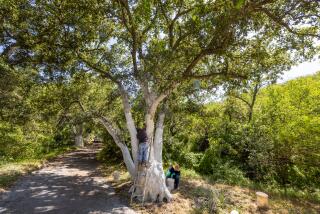Scientists Use Synthetic Sex Lure to Save Torrey Pine Grove
- Share via
LA JOLLA — Using synthetic insect sex chemicals, scientists apparently are saving the last natural grove of the rare Torrey pine on the U.S. mainland from a burrowing beetle.
Three years ago, hundreds of thousands of bark beetles began withering the gnarled, stately trees in the Torrey Pines State Reserve along the coast just north of La Jolla.
Exacerbated by drought conditions that drained sap used by trees to defend against the pests, more than 15% of the reserve’s 7,000 Torrey pines have been killed by Ips paraconfuses , a tiny, shortsighted pest dubbed the “confused five-spined beetle” because of the aimless path it bores under the bark of its host.
“A profound sadness just took over this park as soon as we found out the trees were dying,” said Bob Wohl, supervising ranger at the 1,154-acre reserve.
On Wednesday, a cadre of scientists and park rangers announced the success of a 5-month-old program that looks as though it has put a stop to the bark beetle by luring the creatures into traps before they are able to attack the trees.
Under the direction of Patrick Shea, a research entomologist with the U.S. Forest Service, park staffers began setting a series of cone-shaped traps in May baited with synthesized beetle pheromones, or sex-attracting chemicals.
Now, the same chemicals that in their natural form attract tens of thousands of bark beetles to prey on a single pine are being used to lure the insects into the five-foot-long traps, where they are collected by scientists.
When he began the “trap-out” program in the spring, Shea said, he counted at least 33 trees that had only recently been infected by the bugs, which can colonize and kill a tree within hours.
“In 25 years as an entomologist, I have never seen this beetle kill trees with this kind of intensity,” he said.
Since the traps were set, scientists have captured more than 200,000 beetles with the pheromones, which smell much like turpentine. In the initial stages of the program, researchers collected as many as 29,000 of the bugs per week. Now, that number is down to less than 100, suggesting that the beetle population has thinned considerably.
More to Read
Sign up for Essential California
The most important California stories and recommendations in your inbox every morning.
You may occasionally receive promotional content from the Los Angeles Times.














